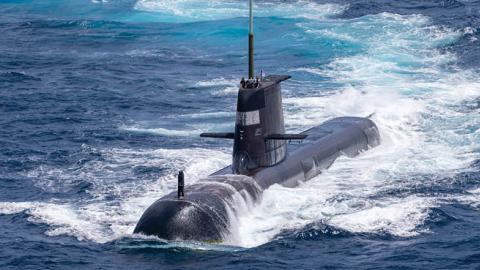As the dust settles in Kabul, will the Biden administration’s recent approach to alliance management impact the increasingly critical alliance-based security architecture being maintained by the United States’ Indo-Pacific allies?
Notwithstanding the US failure at nation building in Afghanistan, the United States remains a formidable military power. Assets now out of Afghanistan can be re-deployed to the Indo-Pacific, identified by both the Trump and Biden administrations as a strategic locus of great-power competition due to Chinese assertiveness in challenging long-standing US interests in the region.
Defeat in Afghanistan, a land that today is of, at best, secondary and possibly even tertiary national interest, should not be assumed to be a harbinger of similar outcomes in the Indo-Pacific, where the United States has long-standing, core strategic interests, as reflected in its alliance-based security treaty commitments to Japan, the Republic of Korea, Australia, the Philippines, and Thailand. In remarks made in Singapore, Vice President Kamala Harris reiterated US interests with respect to Southeast Asia, stating, “There should be no doubt we have enduring interests in this region and we have enduring commitments as well.”1
During the United States’ two-decade-long engagement in Afghanistan, the focus of its Asian allies turned increasingly to developments in the Indo-Pacific. Now is an appropriate time to consider both the evolution of the Indo-Pacific over the past two decades, a period marked by strategic transformation driven by and tied inextricably to the rise of China, and the effects of this evolution on regional order and the US role there—developments that will shape the future of the region long after Afghanistan.
Early in the new century, faced by the challenges posed to Japan’s regional leadership by China’s booming economy and expanding diplomatic influence, the Abe government proposed principles of governance intended to shape the emerging regional community. In remarks made in 2006, Foreign Minister Tarō Asō asserted Japan’s leadership in the region extending from Northeast Asia to Central Asia and the Middle East which, he stated, should be governed by a “values-oriented diplomacy” that emphasizes such “universal values … as democracy, freedom, human rights, the rule of law and the market economy”2 —values and practices contrasting starkly with those of China. A decade later, Asō’s vision evolved into the Abe government’s Free and Open Indo-Pacific strategy,3 which the United States, Australia, and European allies subsequently adopted.4
In the years following, the challenges posed by China acquired increased definition.
As stated in Australia’s 2017 Foreign Policy White Paper, China’s surging economic strength “accelerat[ed] shifts in relative economic and strategic weight,” giving China “power and influence … to match, and, in some cases, exceed [those] of the United States” in parts of the region.5 In 2018, citing China’s activities in the South Pacific, the South China Sea, and the Indian Ocean, a senior government official described Australia’s security environment as the most challenging “since the Coral Sea.”6 Announcing Australia’s 2020 Defence Strategic Update, Prime Minister Morrison observed that Australia has “not seen the conflation of global, economic and strategic uncertainty now being experienced … since the existential threat [it] faced when the global and regional order collapsed in the 1930s and 1940s.”7
New Zealand’s Strategic Defence Policy Statement 2018 stated that China, although “deeply integrated into the rules-based order …, has not consistently adopted the governance and values championed by the order’s traditional leaders.”8 Further, it speculated that China was apparently seeking to “restore claimed historical levels of influence in its periphery as well as an enhanced global leadership role” and observed that “some actions in pursuit of these aims challenge the existing order.”9
Japan’s Diplomatic Bluebook 2019 referenced “unilateral actions” by China that directly challenged a Free and Open Indo-Pacific, terming these as “attempts to change the status quo by force or coercion at sea and in the airspace in … the East and South China Seas based on its own assertions which are incompatible with the existing order of international law of the sea.”10 The Bluebook further cited China’s “unique assertions concerning its territorial rights in the South China Sea, including rejecting the legally binding force of the final award rendered by the Arbitral Tribunal, which confirmed the unlawfulness of China’s land reclamations and other actions.”11
In support of a rules-based order, other countries—individually and in concert with the United States—have moved to counter China’s increasing assertiveness in order to maintain a balance of influence supported by a balance of power.
In 2014, to further strengthen the Japan-US alliance, Prime Minister Abe reinterpreted Japan’s constitution to allow a limited exercise in the right of collective self-defense.12 Additionally, in 2015, Japan joined the United States in issuing new Defense Guidelines that expanded the sphere of bilateral defense cooperation to include third countries13 and increased Japan’s defense budget.14 US-Japan joint exercises have continued to expand, geographically and in complexity, in the East China Sea, the Western Pacific, and the South China Sea.15
In 2015, Japan joined the US-India Malabar exercise as a permanent partner and, in 2019, participated in the US-Australia biennial exercise Talisman Sabre. Japan has also developed capacity-building programs with the Philippines, Malaysia, Indonesia, and Vietnam. In 2016, Japan and ASEAN adopted the Vientiane Vision, a comprehensive plan for defense cooperation, and Tokyo and New Delhi are working together to expand the Japan-India strategic partnership, a relationship marked by annual summit meetings.
The U.S.-Japan Security Consultative Committee’s 2019 “Joint Statement” welcomed the alignment of both countries’ strategic policy documents in expressing concern that “geopolitical competition and coercive attempts to undermine international rules, norms, and institutions present challenges to the Alliance and to the shared vision of a free and open Indo-Pacific.”16
Similarly, in addition to increasing its defense spending, Australia has moved to strengthen its ties with the United States. During the 2019 AUSMIN, the US-Australia alliance committed to building a “secure and prosperous future” in the Indo-Pacific by promoting “freedom of navigation and overflight,” cooperating and coordinating in “capacity building on maritime issues with Indo-Pacific countries,” and “further deepen[ing] trilateral cooperation with Japan and enhanc[ing] engagement with India, including through the Quad.”17
In addition to reiterating the themes of the 2019 AUSMIN “Joint Statement,” the 2020 “Joint Statement” also underscored the growing Australia-US strategic alignment, identifying the Indo-Pacific as “the focus of the alliance” and committing the alliance partners to work “side-by-side” with ASEAN, India, Japan, and the Republic of Korea “to strengthen [the] networked structure of alliances and partnerships to maintain a region that is secure, prosperous, inclusive and rules-based.”18 The “Joint Statement” also “affirmed that Beijing’s maritime claims” with respect to the South China Sea “are not valid under international law.”19 To advance bilateral defense cooperation, the two governments cosigned the classified document “Statement of Principles on Alliance Defense Cooperation and Force Posture Priorities” and set up a Force Posture Working Group aimed at promoting “a secure and stable region and deter[ring] coercive acts and the use of force.”20
Responses to China’s Belt and Road Initiative further evidence the ongoing pushback against China’s assertiveness. The 2017 National Security Strategy of the United States stated, “China’s infrastructure investments and trade strategies reinforce its geopolitical aspirations.”21 In response, in 2018, the United States, Japan, and Australia committed to promoting high-quality infrastructure projects in the Indo-Pacific that would “help to meet the region’s genuine needs while avoiding unsustainable debt burdens.”22 Later, the governments of these nations also joined in creating the Blue Dot Network to advance “transparently-financed, high quality infrastructure through private sector-led development.”23 At the same time, Japan, Australia, and New Zealand increased development aid to the region.24
Over the past two decades, while the United States focused on Afghanistan, the Indo-Pacific was experiencing an evolution in alliance-based, security architecture—transitioning from the Cold War hub-and-spokes construct toward a networked architecture featuring increased security cooperation between US alliance partners, most notably Japan and Australia and Japan and the Philippines; the development of comprehensive and strategic partnerships by Australia, Japan, India, and the United States with Singapore, Vietnam, Indonesia, and Malaysia; and the emergence of multilateral cooperation in the Quad.
In retrospect, the effort to shift the United States’ strategic focus from Afghanistan and the Middle East to the Indo-Pacific began with the Obama administration’s “Rebalance” and is ongoing. As evidenced in the Trump administration’s National Security Strategy25 and the Biden administration’s Interim National Security Guidance,26 the Indo-Pacific rather than Afghanistan has been deeply woven into the foreign and national security strategies of the United States and its Asian allies and strategic partners.
As Washington has increasingly shifted its strategic focus to the Indo-Pacific region, Japan and Australia, conscious of the multiple security challenges posed by China, have assumed greater roles in support of a regional rules-based order. For both Tokyo and Canberra, alliance with the United States remains the foundational element of their foreign policies and national security strategies. Yet, in both countries, concerns about US leadership and commitment have been voiced, dating at least from President Obama’s “red line” retreat in Syria and continuing with President Trump’s alliance management and now the Biden administration’s withdrawal from Afghanistan. In response, both Japan and Australia have moved decisively to hedge against this uncertainty by expanding their engagement in regional security.27
Collectively, their actions, which have increased the prospects of achieving a Free and Open Indo-Pacific, complement the security strategies of both the Trump and Biden administrations. Faced with continuing challenges posed by China, the countries of the region will most likely not cease expanding alliance-based cooperation with the US due to the Afghanistan withdrawal but will, if anything, seek to further strengthen their ties with the United States. For these countries, the harsh geopolitical reality is that taking on China individually constitutes a losing game. Underscoring this strategic reality is Australia’s decision to break with France in the development of conventionally powered submarines and instead join with the US and the UK in developing nuclear-powered submarines. This decision, however, has not come without cost in terms of Franco-Australian relations, again calling into question the Biden administration’s approach to alliance management—in this instance, involving America’s oldest ally.
Today, in the wake of Afghanistan, the Biden administration’s primary challenge will be to restore its claim to competence and its perceived commitment to US alliances and to effective multilateralism—all wounded by the retreat from Kabul. This is therefore not the time for flashy new initiatives but rather for consistent, committed diplomacy. Former Secretary of State George Shultz frequently compared diplomacy to gardening, the attentive care of growing plants.28 Today, the Biden administration would do well to adopt this approach, as the garden of our alliances and strategic partnerships badly needs tending. There is much gardening to be done.



















